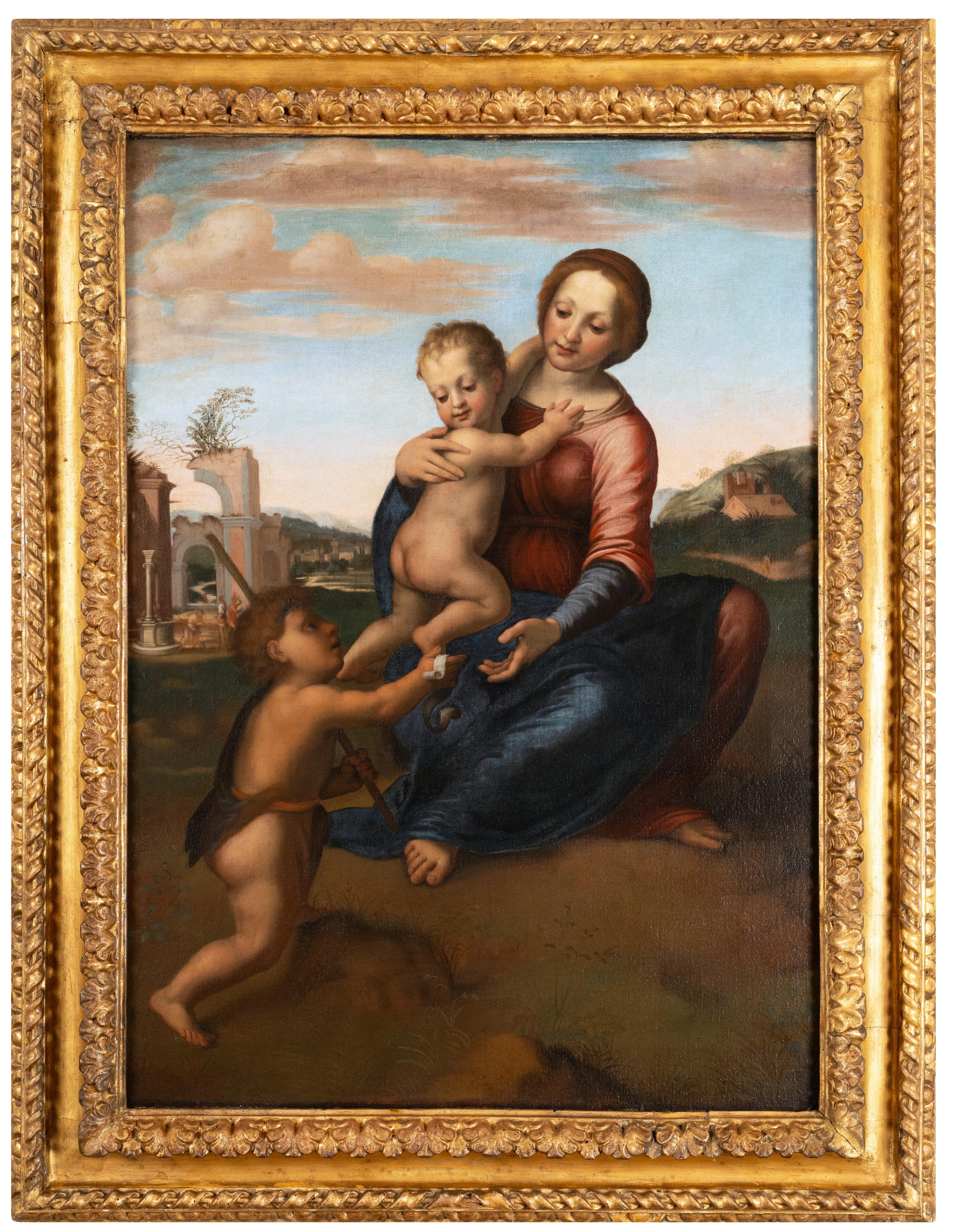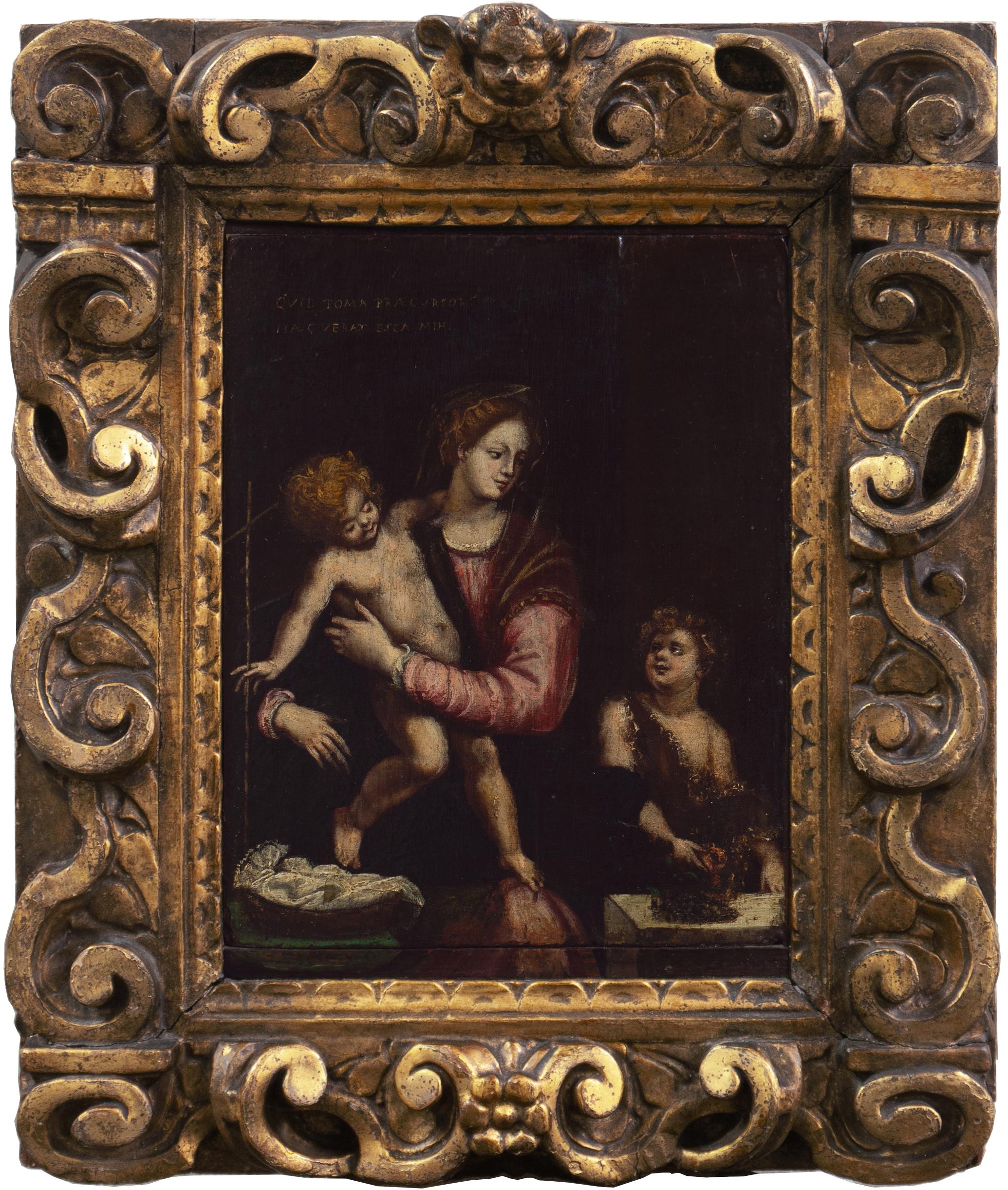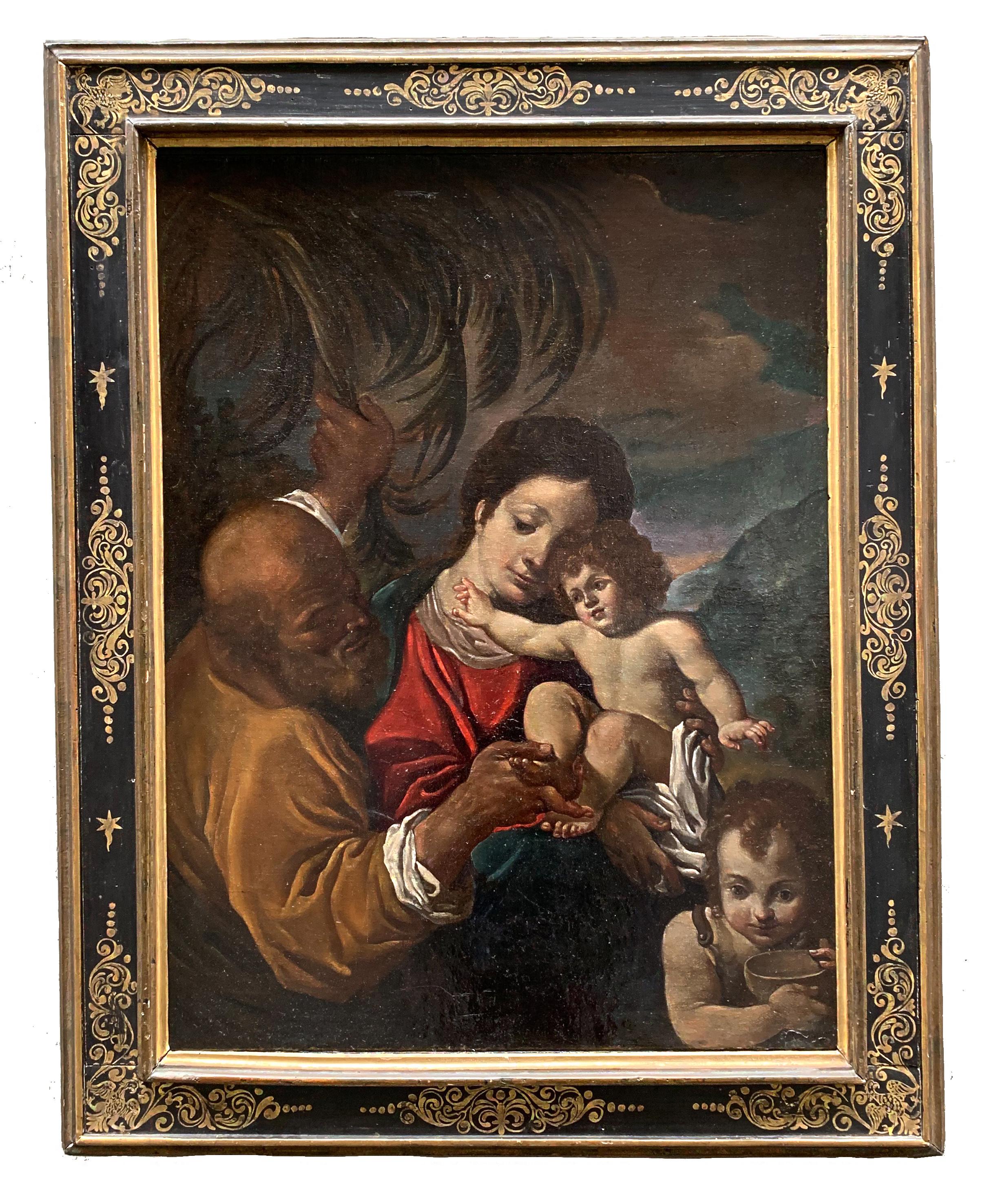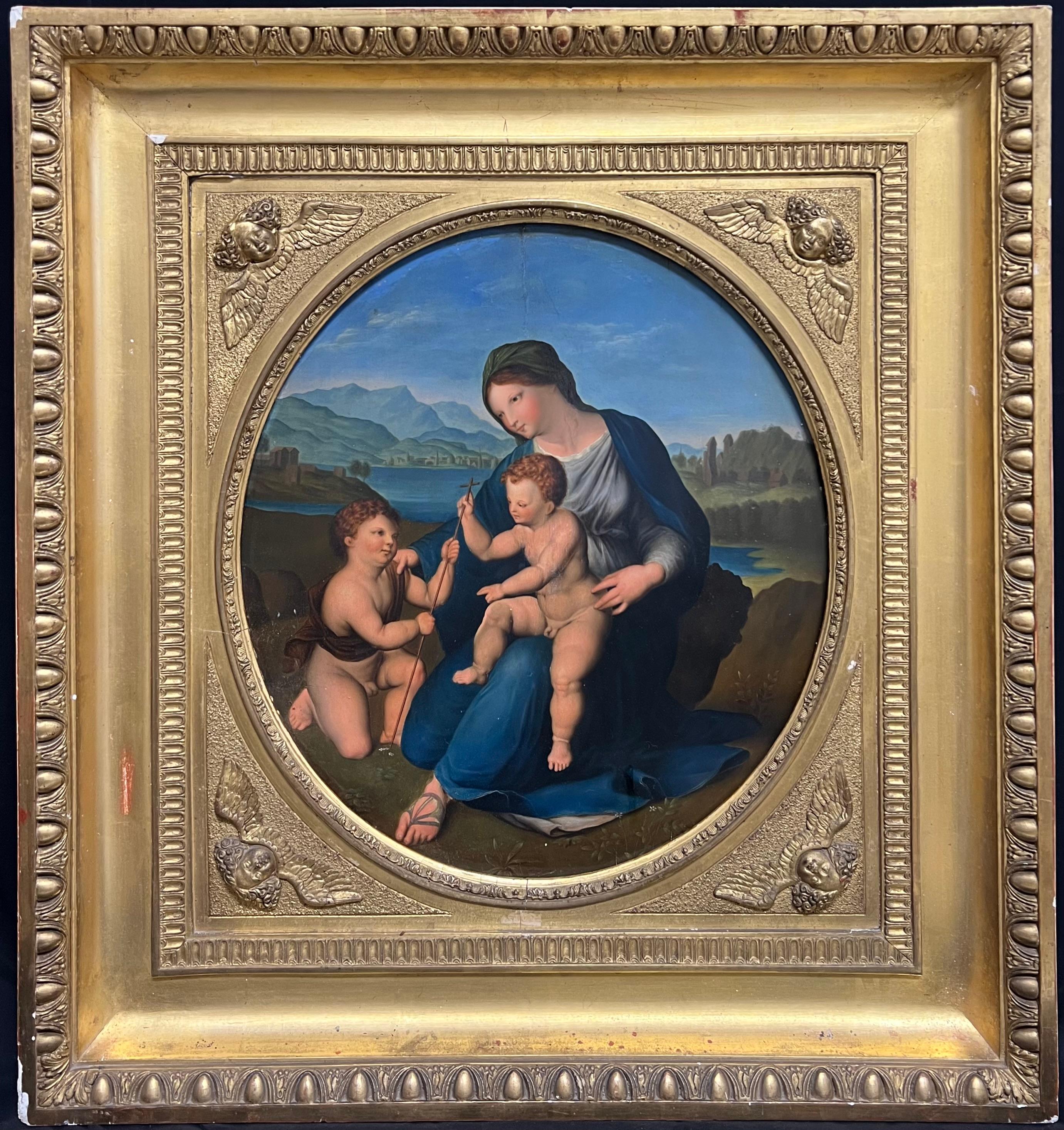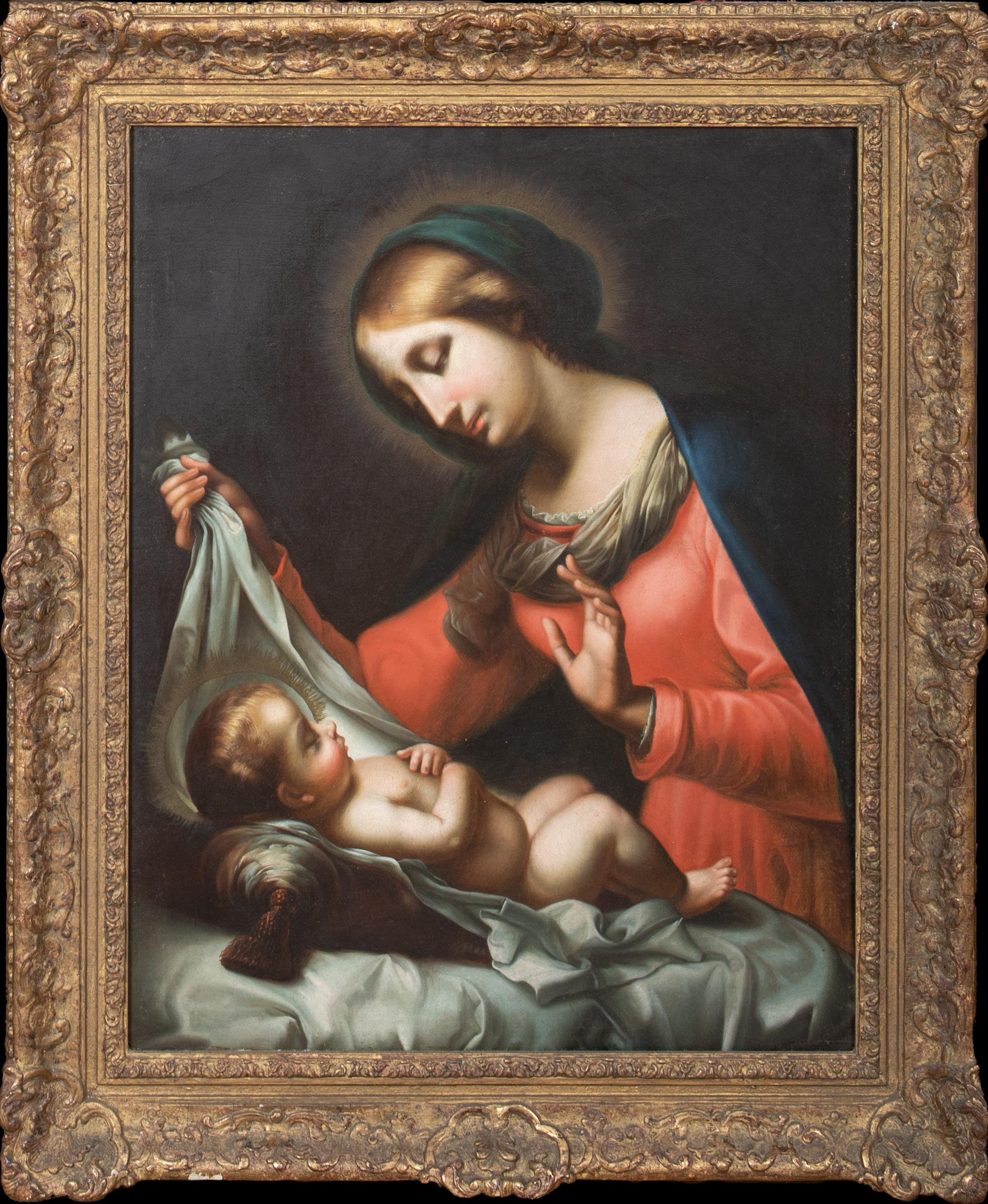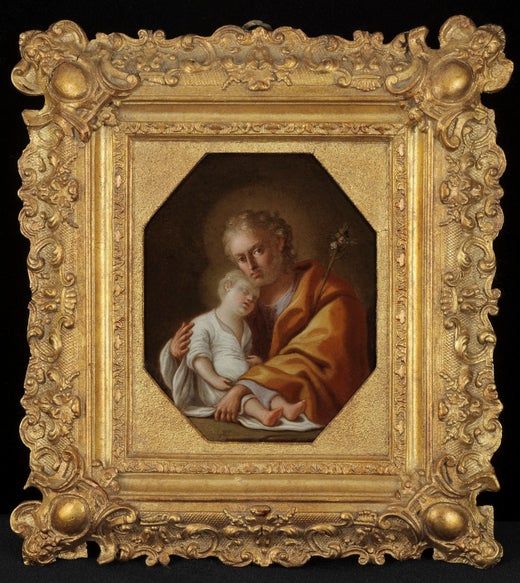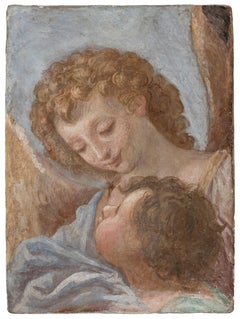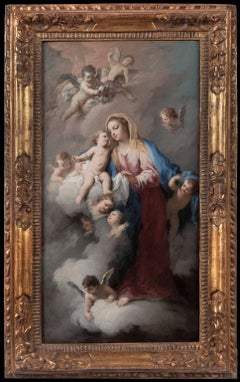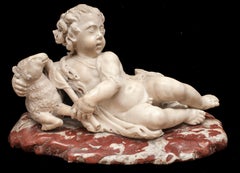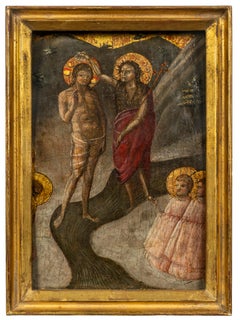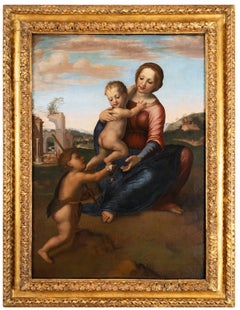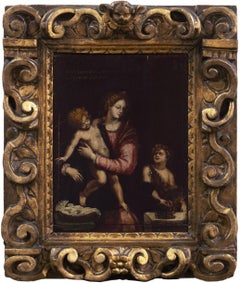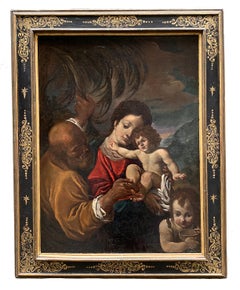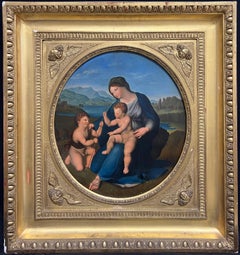Items Similar to Joseph Holding the Christ Child
Want more images or videos?
Request additional images or videos from the seller
1 of 2
Pietro BardellinoJoseph Holding the Christ Child
$17,500
£13,321.35
€15,356.19
CA$24,922.13
A$27,181.91
CHF 14,291.14
MX$328,811.49
NOK 178,335.57
SEK 168,510.16
DKK 114,645.52
About the Item
Provenance: Private Collection, Argentina.
A work of great delicacy and intimacy, this small painting on copper by Pietro Bardellino treats a subject which grew in popularity during the Baroque period: Saint Joseph and the Christ child. The pairing of these two holy figures, with Joseph gently cradling the sleeping child in his arms, serves as a kind of paternal version of the Madonna and Child.
Bardellino was a student of Francesco de Mura, but his style, influenced by that of Corrado Giaquinto and Giacomo del Pò, is somewhat freer and more decorative than that of his master. Among his significant early works is his Last Supper in the Cathedral of Bitonto and the ceiling painting Machaon Curing Menelaus in the Ospedale degli Incurabili in Naples. While noted for his grand decorative projects, Bardellino’s delicacy of touch is evident in his preparatory bozzetti—such as those in the Cleveland Museum of Art and the Gemäldegalerie, Berlin—as well as in his small-scale works (Fig. 1).
Bardellino’s oeuvre varies in scale and subject from large decorative genre paintings to intimate devotional cabinet pictures, such as the present work. Dr. Nicola Spinosa has confirmed the attribution of this painting to Bardellino (written communication) and dates the present painting to around 1760, when Bardellino’s style is especially close to that of De Mura.
- Creator:Pietro Bardellino (1731 - 1806, Italian)
- Dimensions:Height: 5.625 in (14.29 cm)Width: 4.625 in (11.75 cm)
- Medium:
- Movement & Style:
- Period:
- Condition:Excellent.
- Gallery Location:New York, NY
- Reference Number:1stDibs: G13082710273
Pietro Bardellino
Pietro Bardellino, a Neapolitan painter in whose production several comparable allegorical scenes reclaim the french style, in particular, Francois Boucher's inventions from the 18th century of using the childhood theme to embody renaissance and baroque allegories. Bardellino was very active in the decoration of the inners of the noble Neapolitan residences; a lot of work with this aim of the above door had been attributed to him..
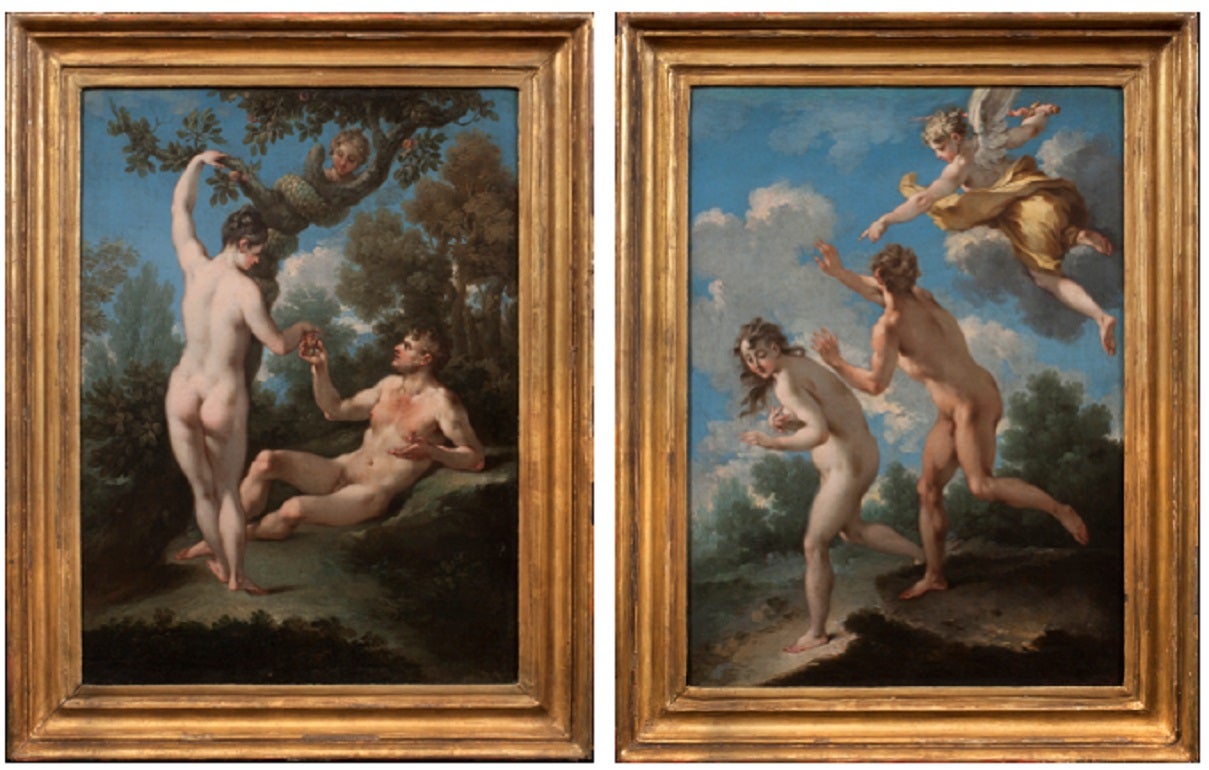
About the Seller
5.0
Recognized Seller
These prestigious sellers are industry leaders and represent the highest echelon for item quality and design.
Established in 1997
1stDibs seller since 2012
22 sales on 1stDibs
Typical response time: 16 hours
- ShippingRetrieving quote...Shipping from: New York, NY
- Return Policy
Authenticity Guarantee
In the unlikely event there’s an issue with an item’s authenticity, contact us within 1 year for a full refund. DetailsMoney-Back Guarantee
If your item is not as described, is damaged in transit, or does not arrive, contact us within 7 days for a full refund. Details24-Hour Cancellation
You have a 24-hour grace period in which to reconsider your purchase, with no questions asked.Vetted Professional Sellers
Our world-class sellers must adhere to strict standards for service and quality, maintaining the integrity of our listings.Price-Match Guarantee
If you find that a seller listed the same item for a lower price elsewhere, we’ll match it.Trusted Global Delivery
Our best-in-class carrier network provides specialized shipping options worldwide, including custom delivery.More From This Seller
View AllA Guardian Angel and a Child
Located in New York, NY
Provenance:
Cornelius Vanderbilt, New York; by whom gifted in 1880 to:
The Metropolitan Museum of Art, New York (80.3.673); deaccessioned and sold:
Christie’s, New York, 12 June 19...
Category
17th Century Old Masters Portrait Paintings
Materials
Terracotta, Gesso
Madonna and Child with Angels in the Clouds
Located in New York, NY
Provenance: Charles H. and Virginia Baldwin, Claremont, Colorado Springs, Colorado ca. 1907-1934; thence by descent until sold in 1949 to:
Charles Blevins Davis, Claremont (renamed Trianon), Colorado Springs 1949 -until gifted in 1952 to:
The Poor Sisters of Saint Francis, Trianon, Colorado Springs, 1952 until acquired, 1960, by:
John W. Metzger, Trianon, renamed as the Trianon School of Fine Arts, Colorado Springs, 1960-1967; when transferred to:
The Metzger Family Foundation, Trianon Art Museum, Denver, 1967 - 2004; thence by descent in the Metzger Family until 2015
Exhibited: Trianon Art Museum, Denver (until 2004)
The present work is a spectacular jewel-like canvas by Amigoni, rich in delicate pastel colors, most likely a modello for an altarpiece either lost or never painted. In it the Madonna stands firmly upon a cloud in the heavens, her Child resting on a delicate veil further supported by a cloud, as he gently wraps his arm around his mother’s neck. From above angels prepare to lower flowers and a wreath, while other angels and seraphim surrounding the two joyfully cavort.
Dr. Annalisa Scarpa, author of the forthcoming monograph on Jacopo Amigoni...
Category
18th Century and Earlier Figurative Paintings
Materials
Canvas, Oil
The Infant Saint John the Baptist with a Lamb
Located in New York, NY
Provenance:
James Byrnes, Los Angeles (1917-2011)
Giusto Le Court was born Josse or Justus de Corte in the Flemish city of Ypres. His father Jean was a sculptor and presumably his earliest training was with him before he entered the studio of Cornelis van Mildert. The young artist was clearly influenced by the dominant Flemish sculptor of the time, Artus Quellinus the Elder, with whom he may have worked on the decoration of the Amsterdam City Hall.
Following the lead of many northern artists he travelled to Rome, perhaps more than once, before settling in Venice around 1655. It was there, as one of a colony of expatriate artists, that he made his name as a sculptor. One of his first Venetian commissions was for the monument to Alvise Mocenigo in the Church of San Lazzaro dei Mendicanti, where Le Court sculpted the marble figures of Strength and Justice. He also collaborated with the celebrated architect Baldassare Longhena, most famously for the high altar of Santa Maria della Salute, where he carved the multi-figured altarpiece depicting the Queen of Heaven Expelling the Plague.
The present marble sculpture depicts the infant Saint John the Baptist, reclining, wearing his traditional hair-shirt, embracing a lamb, and holding the bottom of his attribute, a reed cross. Attached to his shirt is a baptismal cup, with which he would become associated later in his life. Veneration of the infant Saint John the Baptist was prevalent throughout Italy and images of the saint in childhood—often called “Giovannino,” or little John...
Category
17th Century Renaissance Sculptures
Materials
Marble
Baptism of Christ
Located in New York, NY
Provenance:
Achillito Chiesa, Milan
Luigi Albrighi, Florence, by 1 July 1955
with Marcello and Carlo Sestieri, Rome, 1969
Private Collection, Connecticut
Exhibited:
Mount Holyoke College Art Museum, South Hadley, Massachusetts (on loan, 2012)
Literature:
Carlo Volpe, “Alcune restituzioni al Maestro dei Santi Quirico e Giulitta,” in Quaderni di Emblema 2: Miscellanea di Bonsanti, Fahy, Francisci, Gardner, Mortari, Sestieri, Volpe, Zeri, Bergamo, 1973, pp. 19-20, fig. 18, as by the Master of Saints Quiricus and Julitta (now identified as Borghese di Piero).
This fine predella panel depicting the Baptism...
Category
15th Century and Earlier Old Masters Figurative Paintings
Materials
Tempera, Wood Panel
A Guardian Angel Leading a Child
Located in New York, NY
Provenance: Private Collection, Argentina; there acquired by
Mr. and Mrs. Ernest T. Harper, New York, by 1960; by descent to:
Mr. and Mrs. Alan Harper, New York, until 2024.
This s...
Category
18th Century Old Masters Figurative Paintings
Materials
Canvas, Oil
Virgin and Child with Angels Carrying the Cross (Vision of the Cross)
Located in New York, NY
Provenance: Fernandez Jimenez, Spain; part a family collection for over 80 years.
Prints transported to the New World for use in missionary work and religious instruction often serv...
Category
18th Century Old Masters Figurative Paintings
Materials
Canvas, Oil
You May Also Like
17th century Italian school, The Virgin and Child with Saint John the Baptist
Located in PARIS, FR
17th century Italian School
The Virgin and Child with Saint John the Baptist
Oil on canvas
Dimensions: h. 106 cm, l. 77 cm
Important 17th century Italian carved giltwood frame
Fram...
Category
17th Century Old Masters Figurative Paintings
Materials
Canvas, Oil
'Mary with Jesus and St. John the Baptist', 17th Century Milanese School Oil
Located in Santa Cruz, CA
'Mary with Jesus and St. John the Baptist', 17th Century Milanese School Oil
-----
A late 17th century, devotional oil showing the Virgin Mary with Jesus and St. John the Baptist. ...
Category
Mid-17th Century Figurative Paintings
Materials
Gold Leaf
17th century . Holy Family with the Saint John the Baptist - Bolognese School
Located in Firenze, IT
The Holy Family with the Infant Saint John the Baptist - Bolognese School, 17th century
Attribution: Attributable to Francesco Brizio (Bologna, 1574-1623)
Medium: Oil on canvas
Dimen...
Category
17th Century Italian School Figurative Paintings
Materials
Oil, Canvas
18th Century Italian Oil Madonna & Child with St. John the Baptist after Raphael
Located in Cirencester, Gloucestershire
Madonna and Child with St. John the Baptist
Italian artist, 18th century, after the earlier painting by Raphael
oil on wood panel, framed in an Empire, gilt moulded frame
Framed: 23 ...
Category
18th Century Renaissance Figurative Paintings
Materials
Oil
Madonna and child, Italian school, 18th century
Located in DEVENTER, NL
Italian School, 18th century
Depicted are the Madonna and Child Jesus, the virgin Mary is holding the Child Jesus lovingly in her arms. The child, lying on a bundle of cloth and with...
Category
18th Century Figurative Paintings
Materials
Canvas, Oil
Madonna & Sleeping Infant Christ, 18th Century Italian School
Located in Blackwater, GB
Madonna & Sleeping Infant Christ, 18th Century
Italian School
Large 18th century Italian Old Master devotional scene of the Madonna & Child, oil on canvas. Excellent quality and co...
Category
18th Century Portrait Paintings
Materials
Canvas, Oil
$3,170 Sale Price
20% Off
More Ways To Browse
Christ Oil Painting
Antique Last Supper
Cottage Oil
Early 19th Century American Portraits
Lake District
Modern Painting Of Woman
Venezuelan Artist
Oil Painting Kitchen Still Life
Mother And Children
Gloria Vintage
Blue Man
Venice Framed Art
Countryside Oil Painting
Dove Art
Children On Beach Oil Painting
London Landscape Painting
Seascape Original Oil Painting
St Louis Impressionist Paintings St Louis
